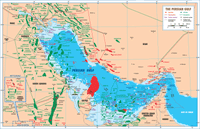|
Aug.
2001 Vol. 222 No. 8
International Outlook
|
MIDDLE EAST
Dr. A. F. Alhajji, Contributing Editor,
Boulder, Colorado
Iran
Higher oil revenues and various economic reforms led to
4.5% growth, almost double the 1999 rate. Iranians re-elected reformer President Mohammed Khatamy to a second
term, despite opposition from hard-liners. Higher oil revenues tripled foreign-exchange reserves between 1998
and 2000, to $9.5 billion. As with other oil producers, Iran – as holder of the second-largest gas
reserves after Russia – is focusing efforts on gas projects, to diversify its economy and earn foreign
exchange by exporting LNG.
Last March, U.S. President George W. Bush renewed an
executive ban on trade and investment with Iran. The U.S. Congress is poised to renew the Iran-Libya Act (set
to expire in August) for another five years. However, deals signed with non-U.S. oil companies prove that U.S.
preemptive moves are ineffective.
Exploration. A new gas discovery was made near
Bandar Abbas in June, in South Gashvieh field in Hermzajan province of southern Iran. The field will start
producing in 2004 and have a capacity of 350 to 425 MMcfgd.
OMV signed a service contract with National Iranian Oil
Co. (NIOC) in April, to participate in a four-year exploration program on the Mehr Block. The deal includes
shooting over 965 sq mi of 2-D seismic and drilling a few wells.
Drilling / development. An overwhelming 96% of
drilling activity continues to be development work. Among last year’s wells, 18 were offshore, up
slightly from 1999’s figure. The number of wells drilled should stay level this year.
Eni and Naft Iran signed a $1-billion contract, to
upgrade 3-billion-bbl Darkhovin oil field in Khuzestan province. This is the first deal based on a new
buy-back formula, which includes performance. The first phase includes drilling eight producing wells. Another
contract was set to be awarded to Spain’s Cepsa, to more than double capacity at Cheshmeh Khosh field.
A new consortium of Japex Indonesia Petroleum and Shell
was formed in June, to develop the 26-billion-bbl Azadegan field, discovered in September 1999. It is
considered Iran’s largest discovery in the last 30 years. Development cost is estimated at $4.5 billion,
and negotiation among different parties should continue until 2002. NIOC has already begun 3-D seismic work
and field development.
Drilling began on the first of 10 horizontal production
wells in the Soroush / Nowruz offshore oil fields. Both fields were damaged during the Iran-Iraq war, and are
being repaired / upgraded. Iran is also enlisting help to develop Bangestan oil field, with three firms
competing for it: Eni, Shell and TotalFinaElf.
Further development is underway in three offshore
fields shared with the UAE – Salman, Nosrat, and Farazan. Petro-Iran Development Co. is developing these
fields and will increase output at Salman by 40,000 bopd.
At the end of 2000, South Pars Oil Co. announced a
pre-qualification tender for phases 9, 10, 11 and 12 of South Pars offshore gas field; 20 firms bought tender
documents. Phases 9 and 10 include production of gas for domestic use, as well as condensate and LPG for
export. Phases 11 and 12 include production of condensate for use in a planned LNG export facility.
Global Geo Services won a $9-million contract, to
conduct a 3-D seismic survey of South Pars. The survey began in May and will cover 1,005 sq mi. As for phases
6, 7 and 8, Enterprise Oil was preparing to drill one of three appraisals. Estimated cost for the three phases
is $2.65 billion. Work includes drilling 30 development wells, and fabricating and installing three offshore
platforms and three 65-mi pipelines to shore.
Last January, Edison Gas acquired exploration rights
for the Munir Block in Khuzestan. In addition, Chinese National Petroleum concluded a two-year, $85-million
contract for drilling 19 gas wells. Drilling was concluded last August at the onshore Homa field, which NIOC
said holds 6.7 Tcf of gas and 82 million bbl of liquefied gas. It can produce 500 MMcfgd.
Production. At the end of 2000, oil production
in Aghajari field, one of Iran’s most important fields, declined to below 1 MMbpd. NIOC believes that gas
injection may bring production back above 1 MMbopd. Despite this decline, Iran’s total oil production
increased 4.5%. However, it varied with changes in its OPEC quota. Production in 2001 is expected to increase
a further 3.6%.
Last April, Iranian officials declared that Iran’s
oil production capacity reached 4 MMbopd. Based on current plans, Iran will double its gas production by 2005.
 |



